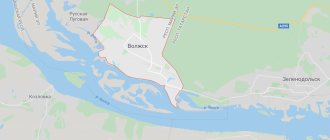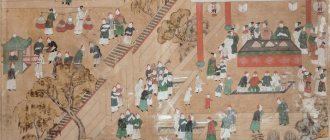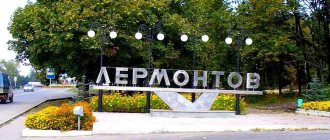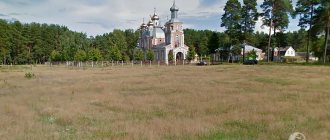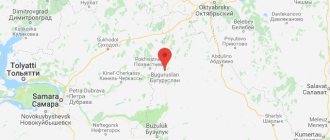People do not come to the city of Bodaibo for tourism purposes. There are no attractions here in the usual sense of the word, and getting here is quite expensive and difficult. If you are looking for where to go in Bodaibo, then you can guess that work has brought you to the Siberian outback. I myself was born “on the mainland”, for several years I came on business trips to this taiga region, and then I got married and became a local resident.
There is only one dirt road leading into the city, which is often washed out by rain.
Bodaibo is called the golden capital of Siberia for good reason. Almost the entire city is filled with artels and gold mining companies. Therefore, there are always a lot of “business travelers”, and they are all looking for something to do in Bodaibo.
Geography
The city is located in the right-bank floodplain valley of the Vitim River, at the confluence of the Bodaibo River, at an altitude of 280 m above sea level. It is surrounded by mountains formed by the spurs of the Kropotkinsky ridge (from the north) and the North Baikal Highlands (from the south).
The surrounding area is a mountain taiga area. In the right-bank floodplain part of Vitim, below the Bodaibo River, there are small areas of agricultural land that have been used since the 19th century. for haymaking, grazing and growing vegetables1.
Sights and interesting facts
Well, we have already found out where Bodaibo is located. What interesting things can a tourist see there, if, of course, he is somehow miraculously carried into this distance?
In fact, there are few attractions in Bodaibo. First of all, a visitor to the city can be advised to go to the local history museum. Here you can learn in great detail about the history of gold mining in the region. The museum, by the way, has surprisingly rich funds. The total number of its exhibits exceeds 14 thousand.
Another iconic landmark of Bodaibo is the historical monument-steam locomotive GR-352. Few people know that at the end of the 19th century a narrow-gauge railway was built here. It connected the Bodaibo mine with the Nadezhdinskaya station. The narrow gauge railway existed until 1968. Then it was dismantled as unnecessary. In memory of her, only a German-made steam locomotive remained in the city, which was brought here by the British at the beginning of the last century.
Transport accessibility
The distance from Bodaibo to the regional center in a straight line is 885 km, along the road (via Taksimo-Severobaykalsk-Zhigalovo) - 1444 km. There is Bodaibo Airport.
Distance from Bodaibo to some cities, km
| City | Distance by road |
| Severobaykalsk | 634 |
| Ust-Kut | 970 |
| Kirensk | 1040 |
| Bratsk | 1339 |
| Irkutsk | 1444 |
| Shelekhov | 1462 |
| Angarsk | 1488 |
| Usolye-Sibirskoye | 1519 |
| Slyudyanka | 1556 |
| Tulun | 1564 |
| Cheremkhovo | 1592 |
| Baykalsk | 1595 |
| Ust-Ilimsk | 1599 |
| Nizhneudinsk | 1687 |
| Taishet | 1844 |
| Ulan-Ude | 1894 |
| Krasnoyarsk | 2213 |
Organizational aspects: how to get there, where to eat, what to get around on, where to live
Even just coming to Bodaibo can be a great adventure. The fastest and most convenient way is by plane. Propeller aircraft fly here from Irkutsk. But the Bodaibo runway is unpaved, so it is often washed away by rain.
Some people take the train to Taksimo and travel the remaining 800 kilometers by taxi. Roads (also dirt roads) are often washed away, so getting stuck in Bodaibo for a few extra days, or even weeks, is a common story. Due to such logistical problems, the city has a huge problem with food. Many stores do not hesitate to sell expired goods, so you need to carefully study the labels before purchasing. Although local businessmen have learned to fake dates on packages. There are several cafes in the city, the quality of food in which also directly depends on the season. In the fall, during prolonged rains, food is not delivered to the city for weeks. Accordingly, the menu in public establishments is sharply reduced.
The whole town fits into one photo.
As for getting around Bodaibo, I can only recommend a taxi. But the town itself is so small that getting around it on foot is not difficult. Of course, in winter, when the temperature reaches −45°, walking down the street for more than 15 minutes is not very pleasant. But the rest of the time, public transport is unlikely to be useful to you.
There are 2 small hotels in the city: “Taiga” and “Noy”. Places in Taiga are reserved by local gold mining companies for their guests. Noah is easier to get to, but be prepared for the fact that there is a bar and billiards on the ground floor. Accordingly, noise is ensured in the evenings. If you need to look for housing on your own, then the only way out is daily apartments. Advertisements can be found on Avito.
Population
Population dynamics
| 1931 | 1939 | 1959 | 1970 | 1979 | 1989 | 1992 | 1996 | 1998 |
| 3500 | 15 100 | 18 226 | 13 898 | 14 411 | 20 939 | 21 700 | 19 800 | 18 700 |
| 2000 | 2001 | 2002 | 2003 | 2005 | 2006 | 2007 | 2008 | 2009 |
| 17 700 | 17 500 | 16 504 | 16 500 | 16 000 | 15 700 | 15 500 | 15 200 | 14 821 |
| 2010 | 2011 | 2012 | 2013 | 2014 | 2015 | 2016 | 2017 | 2018 |
| 15 340 | 15 286 | 14 859 | 14 408 | 14 176 | 13 896 | 13 419 | 13 104 | 12 316 |
| 2019 | 2020 | |||||||
| 11 931 | 11 982 |
Links[edit]
Notes[edit]
- ^ a b Charter of the Irkutsk region
- ^ abc Register of administrative-territorial entities of the Irkutsk region
- ^ abcd Encyclopedia of Russian Cities
. Moscow: Great Russian Encyclopedia. 2003. p. 50. ISBN 5-7107-7399-9. - Russian Federal State Statistics Service (2011). “All-Russian Population Census 2010. Volume 1" [All-Russian Population Census 2010, vol. 1]. All-Russian Population Census 2010 [All-Russian Population Census 2010]
. Federal State Statistics Service. - "26. The size of the permanent population of the Russian Federation by municipalities as of January 1, 2021". Federal State Statistics Service. Retrieved January 23, 2021.
- ^ ab Law No. 49-OZ
- ^ abcde Law No. 67-ounce
- "On the Calculation of Time". Official Internet portal of legal information
. June 3, 2011. Retrieved January 19, 2021. - Post office. Information and computing center of OASU RPO. ( Post office
).
Search for postal service objects ( postal Search for objects
) (in Russian) - "Bodaibo, Russia". Climatebase.ru. Retrieved January 23, 2013.
- "Climate norms for Bodaibo". National Oceanic and Atmospheric Administration. Retrieved January 23, 2013.
Economy
The main economic sector of the city of Bodaibo and the region is gold mining. The annual contribution of the region to the total gold production of the Russian Federation is about 9.3%, of which the share in production from alluvial deposits reaches 18.3%.
The volume of gold production by enterprises in the Bodaibinsky district in 2021 amounted to about 24.8 tons, including about 11 tons of alluvial gold.
33 large and small enterprises in the region are engaged in the extraction of placer gold.
The largest volume of alluvial gold production in 2021 was achieved by ZDK Lenzoloto JSC (with its subsidiaries Svetly JSC, Marakan JSC, Lensib JSC, Sevzoto JSC, Dalnyaya Taiga JSC).
Gold ore mining in the Bodaibinsky district is carried out by JSC Polyus Verninskoye, PJSC Vysochaishy, LLC Druza, LLC GRK Ugakhan2.
Other enterprises: Mamakanskaya HPP, OJSC Vitimzhilstroy, food industry enterprises.
City coat of arms
The city of Bodaibo has its own coat of arms. And quite interesting. It was developed in 2004 according to sketches by Oksana Fefelova.
The red field of the shield depicts a lynx lying on a large chest. Both figures are gold, which is not at all surprising. The chest symbolizes wealth and its increase. But the lynx hints that these riches still need to be obtained, which is not so easy. In addition, this animal is quite common in the forests surrounding the city on all sides.
History of the area
The territory of the region, which historians call the Lena gold-bearing region, was almost uninhabited until 1846. Only rare families of hunters - Evenks and Yakuts - roamed here and settled mainly along the banks of the Lena River. For a long time, the main wealth of the new lands was furs. They hunted, fished, raised deer, and every year in the very center of the taiga, Irkutsk merchants organized fairs at which the indigenous peoples exchanged rich furs for essential goods, jewelry, and tobacco. At one such fair, the Irkutsk merchant Konstantin Petrovich Trapeznikov saw a gold nugget in the hands of the Tungus. This small pebble made the heart of the Irkutsk merchant beat feverishly. Trapeznikov hired the hunter as a guide, and in the summer of 1846, the pioneering “gold diggers” of two search parties simultaneously explored the upper part of the Khomolkho River basin. The first party of the Irkutsk merchant Trapeznikov was led by the Olekma peasant Pyotr Kornilov, and the second party of the actual state councilor Kosma Grigorievich Repinsky was led by the Tobolsk tradesman Nikolai Okulovsky. They found commercial gold deposits and staked out two of the richest areas for mines. Applications were officially registered on September 6 (19), 1846. The taiga, dormant for centuries, was awakened, villages and mines began to appear here and there, horse-drawn roads appeared, the first mines were dug and small hydraulic quarries were opened. In 1885, merchants of the 1st guild Pavel Basnin and Pyotr Katyshevtsev in Irkutsk founded the Lenskoye Gold Mining Partnership (LENZOTO) as a sole enterprise. Later, the entire board of the partnership came under the control of the banking house “I. E. Ginzburg." Gintsburg, who from a small trader turned into a baron, gradually took possession of all the shares and became the rightful owner of the taiga.
The development of the region began from the Far Taiga and gradually reached the Bodaibo River. In the early spring of 1863, a small detachment led by the Cossack Ivan Novitsky left the Far Taiga. Having discovered the Vitim River, Novitsky immediately appreciated its importance for future mines and registered a claim for the territory of the current city. The application was registered in the name of the merchant of the 1st guild, Mikhail Sibiryakov. On June 27 (July 10), 1863, the Stefano-Afanasyevsky allotment was declared. This date is considered to be the date of the discovery and development of our city, and the merchant Sibiryakov as its founder. The territory of the Bodaibo residences began to be built up, and on June 10 (23), 1903, by decree of Tsar Nicholas II, the Bodaibo residence was given the status of a city. Local government bodies were organized there - the Duma and the Council. The board was headed by a headman, who was elected for a term of 4 years and approved by order of the Irkutsk governor.
Why Bodaibo?
Lena old-timers explain the origin of the word, linking it with the past miner’s prayer “Give, God!” ", others say that "Hold it up! ”, i.e. God hid gold, but historians are inclined to believe that the name comes from the Bodaibo river, translated in Evenki as “this area”.
It is difficult to imagine that more than a century and a half ago, progressive and far-sighted merchants were not only able to settle this harsh region, but also build hydroelectric power stations and even a railway here. In 1895, the Industry Company began construction of the Bodaibo narrow-gauge railway from the Bodaibo pier to the company's mines. Track width – 914 mm. The total length of the road was 83 km. At first the road was planned only for transporting cargo, but then they began to carry passengers as well.
Construction of the railway and development of the shipping company
To repair rolling stock, workshops were opened, which later began to repair gold mining equipment and were called TsRMM, and now it is a modern repair enterprise, LenREM LLC. The railway existed until 1967. Gradually, the need for large quantities of fastening timber disappeared, the volume of cargo transportation decreased, and the road became unprofitable. It has been replaced in the area by road transport. And in memory of the Bodaibo railway there remains a monument. A steam locomotive standing on a pedestal of the “GR” series produced in the GDR (1951) is a memory of the first railway in Eastern Siberia.
The rapid development of the gold industry at the Lena mines made a significant change in the economy of the Lena region. The issue of shipping on the river. Lena has been staged since 1838. But the solution to the problem was postponed. And then the Siberian merchant entrepreneurs decided to take the matter of setting up a shipping company into their own hands. It is believed that the Irkutsk merchant of the 1st guild, Ivan Stepanovich Khaminov, is the founder of the shipping company on the river. Lena. 1861 - a steamship was launched for the first time. On March 30, 1864, Irkutsk merchants Sibiryakov, Bazanov and Nemchinov formed the first shipping company, which was called the Leno-Vitim Shipping Company of Sibiryakov, Bazanov and Nemchinov.
Lena execution
Rumors were passed from mouth to mouth about the fabulous riches of the Bodaibo River valley. They talked about discoveries of nuggets of pure gold weighing several pounds, about golden sands that could be raked with shovels. Most of the mines (Uspensky, Nikolsky, Preobrazhensky, Troitsky and others) are named after Christian holidays. The owners believed that God would help them. For the time being, this was true, and not only in terms of enriching the owners. And the workers were treated especially cruelly: the miners lived in barracks, slept on bare wooden bunks, and each worker had only a square meter of “living space.” The working day lasted 11–12 hours. Particular dissatisfaction was caused by the gradual reduction of prices and the continuous rise in food prices. This exhausted the workers' patience. A strike committee was created and demands were drawn up. The negotiations came to nothing. While the “discussion” was going on, an armed team arrived from Kirensk, and when two thousand people, stretching for several kilometers, moved towards the Nadezhdinsky mine, the “black” captain Treshchenkov gave the command: “Fire! » 270 people were killed, 250 were wounded.
A funeral meeting is held annually at the site of the tragedy, attended by veterans, production workers, students, schoolchildren, and members of the public. The memory of the miners' struggle is carefully preserved by descendants.
The formation of Soviet power in the Bodaibo region
The news of the October Revolution also reached distant Lena. On November 29, 1917, the bodies of the overthrown government, the Socialist Revolutionary Party and the Mensheviks convened a joint meeting of the Councils of Bodaibo and the mine region and adopted a resolution on disobedience to Lenin's Council of People's Commissars. But already on December 21, 1917. The Bodaibo newspaper “Lena Taiga” reported that “the Bolsheviks here achieved enormous success among the population.” Soon, in January 1918, Soviet power in the mines was established. The Central Executive Committee of the Soviets was formed, the highest body of the gold mining region. Prominent Bolsheviks were in power in Bodaibo: K.A. Maltsev, P.Ya. Poruchikov, Ya.S. Shcherbinin.
But in the summer of 1918, when the Czech-White Guard revolt swept the whole of Siberia, well-armed white detachments of Rastamashvili and Krasilnikov were moved to the Prilensky region. In contrast to the White Guards, detachments of Red troops under the command of A.S. operated on the Lena. Rydzinsky, A.B. Stoyanovich, T.A. Alymov, etc. The fight lasted for about two months. In the end, the general balance of the fighting forces and the military-technical superiority of the enemy determined the temporary defeat of the Soviets. On August 15, 1918, the White Guards captured Bodaibo. The White Guards shot Alymov and other workers of the Kirensky and Kachug Soviets, dozens of Soviet people, and Red Guards.
The third stage of the movement for the Soviets in the Lena regions should be considered the struggle, mainly against the Kolchak regime in the fall and winter of 1918 and 1919. In January 1919, an anti-Kolchak uprising took place in Bodaibo under the leadership of Nikolai Berezner. It was one of many uprisings that swept through Siberia at that time. Workers and some soldiers took part in the uprising. The Kolchakites brutally suppressed the uprising and executed many of the rebels.
The second half of 1919 was marked by a strong development of the partisan movement. In December 1919, Kolchak’s power was overthrown in Bodaibo; by the end of 1919, even before the arrival of the regular Red Army, the vast territory of the Lena region was liberated from Kolchak’s followers. In the liberated areas, military revolutionary committees or Soviets were created, and congresses of Soviets were convened.
As Soviet power was established, workers' militia were created locally. The general management of its organization was entrusted to the People's Commissariat for Internal Affairs, formed as part of the Council of People's Commissars on November 7, 1917. The main task of the police was to maintain public order and revolutionary legality in the country, to protect state property, property and the person of Soviet citizens.
Creation of Lenzoloto and formation of the Bodaibinsky district
In 1921, the mines were nationalized and the Lenzoloto State Gold Mining Association was created. However, already from October 1, 1925, all the mines of the Lena Partnership were transferred to the English in concession for 30 years. But already on May 31, 1930, a strike of workers was declared demanding the liquidation of the predatory concession, which lasted until August 14. The enterprise came under the jurisdiction of the State Bank of the USSR.
On July 28, 1926, when the Lenzoloto enterprise was going through hard times, document No. 40 of the Presidium of the All-Russian Central Executive Committee was issued, which decided: “The Irkutsk province, which is part of the Siberian Territory, is to be abolished, replacing the existing district division with a district system and approve the division of the territory of the Irkutsk province into districts and districts.” According to this document, the Bodaibo district was formed with its center in the city of Bodaibo. 90 years have passed since that day. The Bodaibinsky district developed and experienced different periods of decline and rise...
Gold production began to grow, but at a slow pace - the damage caused by the British to the Lena mines was too great . In addition, the management of enterprises carried out simultaneously by two organizations, Lena-Bank and Tsvetmetzoloto, could not contribute to the successful development of gold mining in the region. Therefore, in 1932, by Decree of the Government on Lena, the State All-Union Lena Gold Mining Trust “Lenzoloto” was created, which united all the mines of the Lena region. P.A. Etko was appointed the first manager of the trust (1932), and V.V. was appointed chief engineer. Selikhovkin. In 1933, Etko was replaced as trust manager by the experienced leader A.I. Ganin (1933-1937)
Lena miners widely launched the Stakhanov movement, rapid growth of gold mining began due to a radical improvement in the organization of labor, mechanization of labor-intensive processes, commissioning of new and reconstruction of old facilities; in mines, delivery of sand to the dump using an endless rope began to be widely used; Lena miners worked selflessly during the first five-year plans. Stakhanovites completed production tasks by 200-250% every day. For the high performance achieved, a number of Lena miners were awarded Government awards.
Development of medicine and education in the Bodaibo region
The attitude towards medicine in the region at the beginning of the late 19th and early 20th centuries was not the best. There was a trustee hospital with 20 beds. Funds for it were allocated by the board of trustees from the gold miners of the Olekminsky and Vitimsky mining districts. Until 1917, the hospital had three wooden buildings, then the buildings were completed, and only in 1952 the three-story building of the Central Hospital was built. This was done thanks to the initiative of Mikhail Evdokimvich Leonov, Honored Doctor of the RSFSR. Mikhail Ivanovich Prokhotsky, Honored Doctor of the RSFSR, also worked in our hospital. In a later period, such well-known people as Vyacheslav Ivanovich Nikulin, Ekaterina Stepanovna Pulikova, Vera Vladimirovna Ivashkevich and Lyudmila Mikhailovna Kozina and many others worked in the Bodaibo hospital.
Public education in the city and region has rich educational traditions. The first school was opened by the Industry Company on January 18, 1881 at the Uspensky mine. It was a three-year school of the 1st level, in which children from 7 to 13 years old studied. Her first students were 22 boys and 12 girls; they studied the Law of God, the Russian language, arithmetic, learned penmanship, and received some information on Russian history. The number of children in the mines increased, and there was an urgent need for their education. In September 1914, the opening ceremony of the first real school in the city took place. A women's gymnasium (four classes) was organized in October of the same year.
On April 10, 1914, on his initiative, teacher Nikolai Gavrilovich Mungalov, the first congress of mine school teachers was held.
Years of repression and the Great Patriotic War
In 1937, just 10 years after Stalin's second message, in accordance with his theory of the intensification of class struggle as the country moved towards communism, the workers on the banks of the Vitim turned into enemies. But Siberia clearly lagged behind the center in terms of the scale of liquidation of “enemies of the people,” so Boris Petrovich Kulvets was sent from the center.
While carrying out an operation to eradicate enemies, Kulvets was faced with a large scattering of mines in the area. Nevertheless, he managed to organize arrests throughout the vast region and transfer of those arrested to the Bodaibo prison.
Having arrested a mass of people, the emissary formed the case. By all means, he sought confessions from the “accused” of anti-Soviet, counter-revolutionary, espionage and sabotage activities without specifying specific facts.
In total, 948 people were shot in Bodaibo in 1938, which is almost four times more than in 1912. The burial places of the victims of 1938 have not yet been discovered. So the true scale of the terror was actually even greater. The region's economy was practically paralyzed.
On June 22, 1941, the radio brought terrible news - Nazi Germany attacked the Soviet Union. The Lensky Shakhtar newspaper published an emergency issue in the early morning of June 23, notifying the population of the area. A citywide meeting was held in the city garden of railway workers, which was attended by more than 1,500 people.
From the first days of the war, restructuring on a war footing began at the enterprises of the region. The district military registration and enlistment office started working in a military-like manner, quickly and efficiently, preparing to draft the first participants of the war into the army. The recruitment began from subsidiary enterprises.
In 1941, over 2,800 Bodaibino residents were drafted into the army. In all workshops and services of the region, Komsomol youth brigades began to be created, into which women began to join. At the beginning of July 1941, women put forward the slogan: “Women-housewives, master the professions of your husbands.”
The women, with an open letter, addressed all workers in the region with an appeal to donate warm clothes, shoes, government bonds, and cash.
On January 1, 1942, the defense fund was replenished by 5 million 952 thousand rubles. After the defeat of German troops near Moscow in November 1941, the prospectors of the Sergo mine sent a gold personalized watch to General K.D. Golubev, and the prospectors of the Artemovsky mine - to General K.K. Rokossovsky.
In total, during the war years, the workers of the Bodaibo region collected more than nine thousand sets of underwear, shoes, sheepskin coats and other things to the Defense Fund, donated 15 million rubles in money, 18 million rubles. government loan bonds. 94.7 kg of gold mined on Sundays was donated for the restoration of liberated areas.
The rationalization idea also produced the necessary effect: during the war years, the artisanal method of gold mining became widespread. The extraction of precious metal has become a common activity for the entire population of the region.
On March 23, 1944, Yu.V. Chuguev, who showed himself to be a good organizer, was appointed manager of the Lenzoloto trust. In 1944, the Lenzoloto trust initiated a competition for the early implementation of the state gold mining plan among the workers of the country's gold industry and emerged victorious. For this labor victory in 1945, the trust team was awarded and left for eternal storage with the Red Banner of the State Defense Committee and the Council of Ministers of the USSR. The 1946 plan was carried out successfully. By decree of the Presidium of the Supreme Soviet of the USSR dated December 16, 1946, for the successful implementation of the Government’s gold mining assignments and in connection with the 100th anniversary of the Lena mines, the trust was awarded the Order of Lenin and became the first order-bearing team in the country’s gold industry. 126 workers and engineers were awarded orders and medals. The Order of Lenin was awarded to: Yu.V. Chuguev, trust manager, F.G. Zherdev, chief engineer, G.N. Sherstyannikov, foreman-miner, as well as miners A.M. Popov, P.S. Poyarkin.
On the square in the center of Bodaibo there is a monument in memory of the Bodaibo soldiers who died on the fronts of the Great Patriotic War. For military exploits, many were awarded orders and medals: BH Streltsov, I.P. Bolodurin, P.V.
Bochkarev was awarded the title of Hero of the Soviet Union, A.F. Babich became a full holder of the Order of Glory.
The victory for our people came at a high price. More than 13 thousand Bodaibo residents went to the front, more than 3.5 thousand people never returned to their homes, and this list is not yet complete. The search for names continues...
Bodaibinsky district in the 1960-70s
The first wave of stone buildings began immediately after the end of the war. In June 1959, SMU-3 of the Dragstroymontazh trust was organized, and thanks to the builders, a new rise in brick, and since 1977, large-panel housing construction began in Bodaibo. The trust's specialists installed almost all the dredges and walking excavators in the area, built the plant's auto repair shops, heating boiler houses and heating networks, treatment facilities, water supply and much more. Comfortable houses, educational institutions, new clubs, shops, canteens, hospitals and first aid stations were put into operation.
The pilots of the Bodaibo squadron, organized in April 1962, which two years later was transformed into an airline, successfully transported passengers and cargo.
Education, culture, sports, healthcare and other businesses developed in the area.
In 1980, a city local history museum opened in Bodaibo. Its founder and first director was V.F. Vereshchagin.
